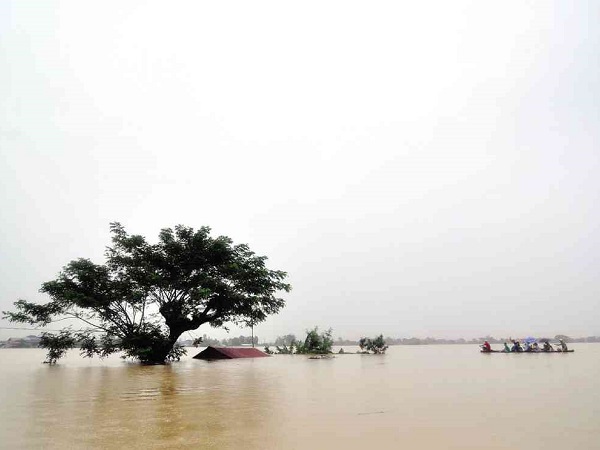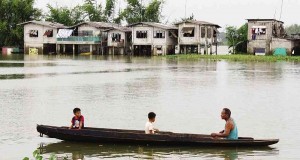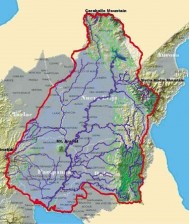No funds for flood control in Pampanga River Basin

PEOPLE in a boat cross flooded roads and rice fields in San Simon, Pampanga, in this photo taken in 2011. RICHARD A. REYES
The Pampanga River Basin (PRB), the main drainer of northern and Central Luzon, was not in the list of P351-billion worth of flood control projects that the National Economic and Development Authority (Neda) approved in September 2012.
That budget, Public Works Secretary Rogelio Singson clarified, covered only 11 infrastructure projects, mostly in Metro Manila.
Three projects in Bulacan—the Meycauayan river improvements (P14.04 billion), Valenzuela-Obando-Meycauayan river improvements (P8.631 billion) and strengthening of Angat Dam and dike project, (P5.7 billion)—made it to the list as these are immediately northwest of the country’s capital.
It puzzled some leaders in Central Luzon why the PRB was not on top of the priorities when all the way from the Caraballo mountains, it empties out to Manila Bay.
Central Luzon also experienced severe floods between 2000 and 2011 that left 455 people dead, 186 hurt and P28.533 billion in trails of damage, records from the Office of Civil Defense showed.
In the floods spawned by the southwest monsoon rains in August 2012, 46 people died, mostly from drowning. The damage on roads, bridges, dikes, crops and fishponds reached P2.036 billion.
But Singson said Central Luzon was never left out. “Studies on flood mitigation in nearby regions [of Metro Manila] are ongoing,” he said in a text message to the Inquirer.

IN THE CANDABA Swamp, a natural flood drain in Candaba, Pampanga, residents cope with high waters by building their houses on concrete stilts and using boats to move around. TONETTE OREJAS
The initial allocation of P5 billion included four items in Central Luzon: the repair of damaged flood-control structures in the City of San Fernando (P272.19 million) and in the Department of Public Works and Highways’ (DPWH) districts in Pampanga (P64 million), Tarlac 1 (P71 million) and Zambales 1 (P36 million). None of these is directly related to the PRB, though.
The last major flood-control project in Central Luzon was the Pampanga Delta Development Project Phase 1, which was conceived in 1978 but completed only in 2002.
Another study
Antonio Molano Jr., public works regional director, said his office had begun sharing data with the consultants of what he described a comprehensive study for flood mitigation in Metro Manila and outlying provinces.
This is being done although the National Water Resources Board (NWRB) and the Japan International Cooperation Agency (Jica), through a loan, had tapped a joint venture that undertook starting 2009 a study on the Integrated Water Resources Management (IWRM) program, Inquirer research showed.
The Regional Development Council (RDC) adopted the IWRM approach in a proposal submitted to President Aquino after Typhoons “Pedring” and “Quiel” battered Central Luzon in 2011.
The strategic interventions in the PRB are disaster mitigation and forecasting, forestation and revegetation, renewal and redevelopment for flood-proofing, capability building and institutional arrangements, wetlands and coastal resources management, water pricing, structural and nonstructural measures, and water detention and basin establishment.
So far, the RDC has formed the PRB Committee and endorsed several projects, including the revival of the Pampanga Delta development program (PDDP) Phase 2, Tarlac River improvement project, Western River basin flood control project, Dinalupihan-Hermosa-Lubao flood control project and Central Luzon Expressway project.
It also asked the Neda board infrastructure committee to unify the dam management protocols of NIA, NWRB, the weather bureau Pagasa and National Power Corp.
Managing the PRB
In June last year, the Department of the Interior and Local Government, Local Government Academy, Agencia Española de Cooperacion International para el Desarrollo and Sen. Loren Legarda gathered some 300 leaders in Central Luzon’s public and private sectors. In workshops, they identified issues and opportunities on leadership of the alliance, representation of sectors, sources of funds, and performance evaluation standards to obtain the seal of disaster preparedness.
A proposal to revive the DPWH’s Pampanga River Control System (PRCS) emerged on the heels of monsoon rains last year. Proposed by Bulacan Gov. Wilhelmino Sy-Alvarado, who cochairs the PRB committee with Tarlac Gov. Victor Yap, the PRCS revival plan has been detailed by the DPWH.
But there is no resolution yet at the RDC seeking the PRCS revival. What is on RDC file is a resolution for the development of a framework for the PDDP 2 in Bulacan.
Pampanga Board Member Nestor Tolentino, a former PRCS engineer, said it is necessary to revive the PRCS “to ensure regular dredging and other maintenance works in the PRB using common high standards.” The provincial board, through a resolution that Tolentino filed, backed Alvarado’s proposal.
Lita Manalo, assistant director of the Mount Pinatubo Emergency Project Management Office (MPE-PMO), said the region needs a single unit specializing in flood control.
For now, the regional DPWH, MPE-PMO and engineering districts do the task.
Master plans
There has been no lack of master plans in river basins, a DPWH report showed.
Those completed include the Amburayan in the Ilocos and Cordillera worth P37.6 million. Feasibility studies were reported to be ongoing for Bauang (Ilocos and Cordillera at P14.7 million), Pamplona (Cagayan Valley and Cordillera at P27.8 million) and Sta. Rita-Kalaklan (Olongapo City at P8.53 million).
Several river basins got funding even without plans. These were the Agno Upstream in Pangasinan (P295 million), Abra (Cordillera at P100.9 million), Patalan-Cayanga-Angalacan (Ilocos and Cordillera at P66.3 million), Sinocalan-Marosoy-Dagupan (Ilocos and Cordillera at P159.3 million), Abulug (Cagayan Valley and Cordillera at P192.09 million), Nangalisan-Baggao-Pared (Cagayan Valley and Cordillera at P648.7 million) and Angat (Central Luzon at P42.8 million).
